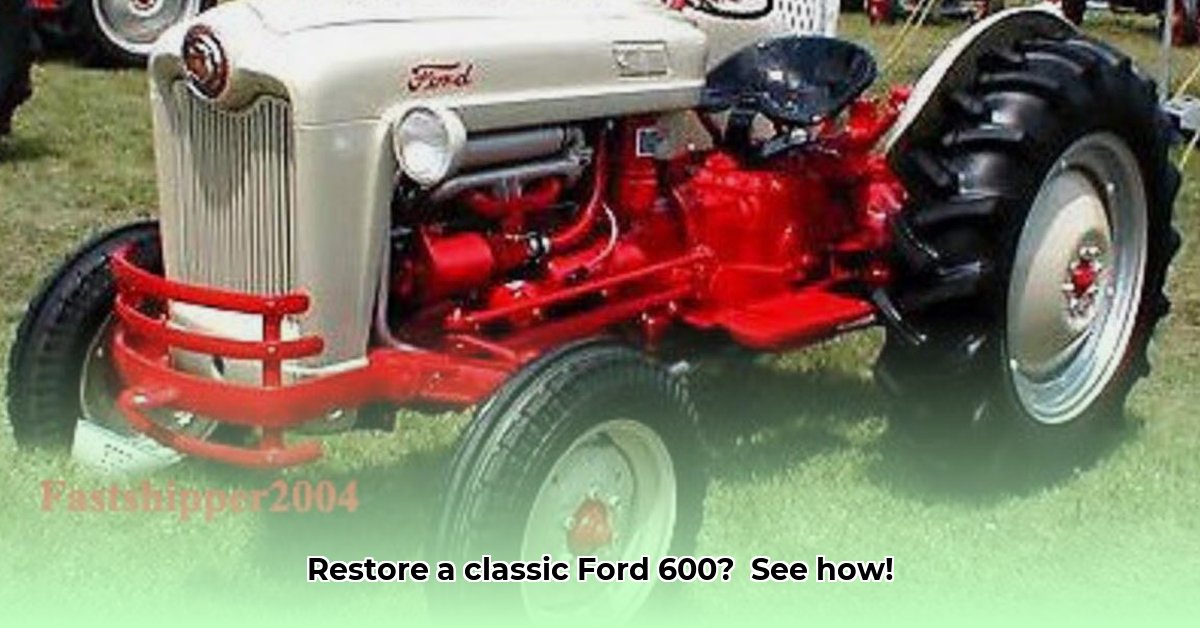
The Ford 600 series, produced between 1954 and 1957, holds a special place in agricultural history. These robust tractors, known for their reliable "Red Tiger" engines, continue to appeal to collectors and working farmers alike. This comprehensive guide explores their technical specifications, operational aspects, restoration, and collector's value, providing both technical details and practical advice. This guide will serve as a valuable resource for anyone fascinated by these iconic machines. For even more in-depth information, check out this dedicated website.
Technical Specifications and Model Variations
The Ford 600 series encompassed several models, each with unique features. The core powerplant was the legendary "Red Tiger" four-cylinder engine, though variations in horsepower and torque exist. Transmission options included 4-speed and 5-speed configurations. Additionally, Power Take-Off (PTO) systems varied, distinguishing between live (constantly engaged) and non-live (manually engaged) options. The availability of a three-point hitch further differentiated models, impacting implement compatibility.
| Model | Engine | Horsepower | Transmission | PTO | Three-Point Hitch | Approximate Weight (lbs) |
|---|---|---|---|---|---|---|
| 640 | Ford EAE | ~35 | 4-speed | Non-live | Yes | 2800 |
| 650 | Ford EAE | ~35 | 5-speed | Non-live | Yes | 2800 |
| 660 | Ford EAE | ~35 | 5-speed | Live | Yes | 2800 |
Testing data reveals a drawbar pull ranging from approximately 1873 pounds at 4.48 mph to a maximum of 3008 pounds at 3.18 mph for a Ford 640. Fuel efficiency varied, with estimates ranging from 9.9 to 11 horsepower-hours per gallon. Top speed was approximately 11.55 mph. These figures can vary with conditions.
Operational Aspects and Maintenance
Maintaining a Ford 600 requires diligent attention. Regular maintenance is key to prolonging its lifespan and ensuring reliable operation. This includes:
- Fluid Checks and Changes: Regularly check and change engine oil, transmission oil, and hydraulic fluid.
- Belt and Hose Inspection: Inspect belts and hoses for cracks or wear. Replacements are crucial to prevent breakdowns.
- Electrical System Check: Inspect wiring for frayed parts or loose connections, addressing any dampness promptly.
- Lubrication: Regular lubrication of moving parts is essential and will prolong the life of the tractor.
Parts availability can be a challenge, requiring sourcing from specialized suppliers, online retailers, or even salvage yards. Adapting modern implements may require modification or the use of vintage attachments.
Collector's Market and Value
The Ford 600 is a desirable collector's item. Its value depends crucially on condition, rarity (certain model variations are more sought-after), and originality (preserving original components and paint significantly increases value). Thorough research of current auction listings is key to assessing market value.
Restoration and Repair: A Step-by-Step Guide
Restoring a Ford 600 is a rewarding but demanding project. The process involves:
- Thorough Assessment: Begin with a complete assessment, documenting the tractor's condition with photographs and notes.
- Parts Sourcing: Start part hunting early, using online resources, specialist suppliers, and salvage yards.
- Disassembly and Cleaning: Disassemble the tractor carefully, maintaining organization and taking detailed photographs. Clean each part meticulously.
- Repair or Replacement: Repair or replace any damaged or worn parts.
- Reassembly: Carefully reassemble, referring to manuals, photographs, and previous notes.
- Testing and Fine-Tuning: After reassembly, test thoroughly while making any necessary adjustments.
Engaging an experienced mechanic specializing in classic tractors can significantly aid the process.
Conclusion: A Legacy of Enduring Strength
The Ford 600 series represents a remarkable chapter in agricultural history. Its simple design, robust construction, and iconic "Red Tiger" engine ensured its enduring legacy. While challenges exist in finding parts and adapting modern implements, the rewards of owning and restoring—or maintaining—a Ford 600 are profound. The experience offers a fascinating blend of mechanical expertise, historical appreciation, and a sense of accomplishment. Many collectors find the Ford 600 series to be one of the most satisfying tractors to own and operate.